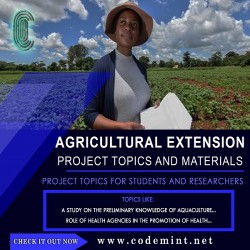- The Complete Research Material is averagely 125 pages long and it is in Ms Word Format, it has 1-5 Chapters.
- Major Attributes are Abstract, All Chapters, Figures, Appendix, References.
- Study Level: MTech, MSc or PhD.
- Full Access Fee: ₦8,000
Get the complete project »

Abstract
The main driv,ing force for farmers to become engaged in urban agriculture are food security and income generation (poverty alleviation). In fact, urban agriculture is important for public health and sustainable resource management. Yet most governments have under-rated and overlooked it. In Enugu State there is no specific policy to encourage urban agriculture despite its contributions to food and income levels of the poor urban households. Therefore, the purpose of this study was to determine the needs of urban farm operators in Enugu urban. Specifically, the objectives of the study include: (1) to find out agricultural activities engaged in by urban farm operators; (2) determine land and labour needs of urban farm operators; (3) determine water, input supply and credit needs of urban farm operators; (4) determine the marketing needs of urban farm operators;
(5) determine the farmer education needs of urban farm operators. Five research questions and two null hypotheses were formulated to guide the study. A survey research design was adopted for the study. A structured questionnaire consisting of 108 items was administered to 220 respondents purposively sampled from a population of 330 urban farm operators using accidental techniques. Data collected were analyzed using percentage, mean and standard deviation for the research questions while t-test statistic was used to test the hypotheses. The study found out that: (1) Urban farm operators eng,aged in urban horticulture, urban livestock and urban forestry.
(2) Land spaces available for urban agricultural activities were backyard,
borrowed and rented land. Other spaces are plastic bags, cans and baskets. Hired and family labour were the only labour available. (3) Rainwater, river1 stream and well were the only sources of water. Inputs like improved seeds, seedlings, chemicals and micro-credits were needed for agricultural practices. (4) Marketing needs like processing, packaging and preservation were required by urban farm operators. (5) Extension service needs like extension agents organizing workshops and seminars,
establishing clubs and co-operatives etc were the needs of urban farm operators. (6) Some training needs like how to gain access to land, choice of crops to grow, use of organic waste 2nd wastewater, use of limited water supply, protection of crops, dealing with animal, waste, knowledge of packing, market and outlets, etc. were the needs of urban farm operators. Based on the findings, the following
recommendations were made: (1) Government should recognize urban farm operators as integral group of the farming ~perators~by
institutionalizing urban agriculture programmes. (2) The Ministries of Lands, Agriculture and ADPs should include urban agriculture in their policies and programmes. (3) Federal and State governments should train and mobilize more extension workers to render the service and training needs of the urban farm operators.
CHAPTER ONE
INTRODUCTION
Background of the Study
Throughout the globe, urban agriculture is increasingly a part of city landscape. Like many urban trends, urban agriculture crosses borders North and South and is evident in both rich and poor countries. It is found in small towns, major cities, industrial, financial and governmental urban centres. It is found in temperate and in tropical latitudes and at sea level and high in the mountains. The United Nations Development programme
. (UNDP) estimates that as many as 800 million urban residents are involved in commercial and subsistence agriculture in or around the cities (UNDP, 1996).
Enugu is the capital, the largest commercial centre and the seat of political and administrative power of Enugu State. In Enugu city, farming activities are everywhere, not only in the outskirt but also in the heart of the city. In all kinds of open public spaces crops are cultivated and animals like goats, sheep roam around. In fact, there is even more farming, notably in backyard and in the residential areas. People of all socio-economic classes grow food crops whenever and wherever possible.
Urban agriculture is therefore an industry located within (intra urban) or in the fringe (peri-urban) of a town, a city or a metropolis. It grows or raises, processes and distributes a diversity of food and non-food products (re)-using largely human and material resources, products and services from
within and around that urban area. And in turn supplying human and material reso,urces, products and services largely to that urban area (Mougeot, 1999).
Clearly urban areas in developing and developed countries are often very different. The usual mechanism, common in national censuses is to take population thresholds. Once a nucleated settlement grows beyond a certain threshold, it becomes "urban". However, the threshold used varies widely from country to country and may even change in successive censuses (Hardoy and Satterthwaite, 1986). However, the United ~ d i o n s
(1991) has attempted to standardize data by defining settlement of over 20,000 people as "urban", over 100,000 people as cities and over 5 million as big cities.
The main driving force for farmers to become engaged in urban agriculture are food security and income generation. According to the urban Agriculture Network (TUAN) of the roughly 800 million people currently involved in urban agriculture worldwide, 200 million produce for the market and 150 million are full time employees. Between 1993 and 2005, urban agriculture could increase its share of world food production from 15% to 33%, its share of vegetables, meat, fish and dairy products consumed in cities from 33% to 50% and the number of urban farmers producing for the market from 200 million to 400 millions (Mougeot, Farugui, Smith, Wilson and Hovorka, 1998).
Apart from food security and poverty alleviation, urban agriculture is important for public health and sustainable resource management. The
direct impacts are improved health conditions among urban farmers through a richer vitamin and protein diets. Furthermore, more appropriate waste management practices lead to decrease in health risks. Sustainable resource management implies a more efficient use of resources, including a reduction and reuse of waste flows whenever possible. Closing the nutrient loop in the urban environment by reusing the so-called waste as fertilizers in urban agriculture is an option to the prevalent open-loop and linear urban system (Smit, 1996 in Baumgartner and Beelvi, 2001).
The urban farm operators (urban farmers) do not form a homogeneous group. They can be found in almost every socio-economic group of the city. Mougeot (1993) identifies three farmer categories, divided according to the reasons for practising urban agriculture:
Low-income survival farmers.
rn
Middle-income home gardeners - These practise urban agriculture mainly to provide supplemental food and/or income. In this second category are the upper-class people who have their gardens maintained by their servants and watchmen.
rn
You either get what you want or your money back. T&C Apply

You can find more project topics easily, just search
-
SIMILAR AGRICULTURAL EXTENSION FINAL YEAR PROJECT RESEARCH TOPICS
-
1. EFFECT OF SOY GROUNDNUT MIXED GRAIN COMPLEMENTARY FOOD ON THE LEVEL OF SELECTED GROWTH IN MALE WEANING WISTAR RATS
» CHAPTER ONE 1.0 INTRODUCTION 1.1 BACKGROUND OF STUDY Soybean is one of the most economical and nutritious foods which can combat the diseases stemming...Continue Reading »Item Type & Format: Project Material - Ms Word | 44 pages |
 Instant Download
|
Chapter 1-5 |
AGRICULTURAL EXTENSION DEPARTMENT
Instant Download
|
Chapter 1-5 |
AGRICULTURAL EXTENSION DEPARTMENT
-
2. CYTOGENETIC SCREENING OF DIFFERENT BREEDS OF RABBIT FOR GROWTH POTENTIALS IN A WARM HUMID TROPICAL ENVIRONMENT
» ABSTRACT The study was carried out to determine the x chromatin status of different breeds of rabbit and their crosses. The genotypes were Newzealand ...Continue Reading »Item Type & Format: Project Material - Ms Word | 52 pages |
 Instant Download
|
Chapter 1-5 |
AGRICULTURAL EXTENSION DEPARTMENT
Instant Download
|
Chapter 1-5 |
AGRICULTURAL EXTENSION DEPARTMENT
-
3. FACTORS INFLUENCING PARTICIPATION OF FARMERS IN BROWN SUGAR PROCESSING IN SELECTED LOCAL GOVERNMENT AREAS OF KADUNA STATE, NIGERIA
» ABSTRACT The study was conducted to assess farmer‘s participation in brown sugar processing in Makarfi, Soba and Kubau LGAs. A multistage sampli...Continue Reading »Item Type & Format: Project Material - Ms Word | 52 pages |
 Instant Download
|
Chapter 1-5 |
AGRICULTURAL EXTENSION DEPARTMENT
Instant Download
|
Chapter 1-5 |
AGRICULTURAL EXTENSION DEPARTMENT
-
4. ECONOMIC ANALYSIS OF PROCESSING AND MARKETING OF CASHEW PRODUCTS IN UDENU LOCAL AREA, ENUGU STATE
» ABSTRACT This study aims in identification of cashew products that can be utilized in cashew. This ranges from cashew nuts, apple and cashew nut shell...Continue Reading »Item Type & Format: Project Material - Ms Word | 50 pages |
 Instant Download
|
Chapter 1-5 |
AGRICULTURAL EXTENSION DEPARTMENT
Instant Download
|
Chapter 1-5 |
AGRICULTURAL EXTENSION DEPARTMENT
-
5. THE EFFECT OF INFLATION AND INTEREST RATE ON AGRICULTURAL PRODUCTIVITY IN NIGERIA FROM 2000-2015
» CHAPTER ONE INTRODUCTION 1.1 Background of the study Inflation has been apparent in Nigeria from the outset of her national life as it was propelled i...Continue Reading »Item Type & Format: Project Material - Ms Word | 56 pages |
 Instant Download
|
Chapter 1-5 |
AGRICULTURAL EXTENSION DEPARTMENT
Instant Download
|
Chapter 1-5 |
AGRICULTURAL EXTENSION DEPARTMENT
-
6. FACTORS INFLUENCING ADOPTION OF FARO 52 RICE PACKAGE BY FARMERS IN SELECTED LOCAL GOVERNMENT AREAS OF NIGER STATE, NIGERIA
» ABSTRACTThe study assessed the factors influencing adoption of FARO 52 rice package by farmers in selected Local Government Areas of Niger state. Stru...Continue Reading »Item Type & Format: Project Material - Ms Word | 127 pages |
 Instant Download
|
Chapter 1-5 |
AGRICULTURAL EXTENSION DEPARTMENT
Instant Download
|
Chapter 1-5 |
AGRICULTURAL EXTENSION DEPARTMENT
-
7. HETEROSIS AND COMBINING ABILITY FOR SUGAR CONTENT AND GRAIN YIELD IN SWEET AND GRAIN SORGHUM (SORGHUM BICOLOR L. MOENCH) HYBRIDS
» ABSTRACT This research was conducted to study heterosis and inheritance of sugar, grain yield and other agronomic traits in sweet sorghum. The parenta...Continue Reading »Item Type & Format: Project Material - Ms Word | 89 pages |
 Instant Download
|
Chapter 1-5 |
AGRICULTURAL EXTENSION DEPARTMENT
Instant Download
|
Chapter 1-5 |
AGRICULTURAL EXTENSION DEPARTMENT
-
8. AVAILABILITY AND USE OF SWAMP RICE PRODUCTION TECHNOLOGIES AMONG FARMERS IN ENUGU STATE NIGERIA.
» xi ABSTRACT In spite of the use of available production technologies by swamp rice farmers, much of the world’s intensive food production is sti...Continue Reading »Item Type & Format: Project Material - Ms Word | 106 pages |
 Instant Download
|
Chapter 1-5 |
AGRICULTURAL EXTENSION DEPARTMENT
Instant Download
|
Chapter 1-5 |
AGRICULTURAL EXTENSION DEPARTMENT
-
9. EVALUATING THE IMPACT OF EXTENSION WORKERS ON AGRICULTURAL DEVELOPMENT AMONG RURAL FARMERS IN ESIT EKET LOCAL GOVERNMENT AREA, AKWA IBOM STATE, NIGERI...
» ABSTRACT The term curriculum refers to the lessons and academic content taught in a school or in a specific course or program. However, experiences ov...Continue Reading »Item Type & Format: Project Material - Ms Word | 52 pages |
 Instant Download
|
Chapter 1-5 |
AGRICULTURAL EXTENSION DEPARTMENT
Instant Download
|
Chapter 1-5 |
AGRICULTURAL EXTENSION DEPARTMENT
-
10. THE ROLE OF AGRICULTURAL INSURANCE IN ENHANCING AGRICULTURAL PRODUCTIVITY
» Abstract Insurance is needed in order to alleviate the financial losses suffered by policy holders or the general public where the liability under pol...Continue Reading »Item Type & Format: Project Material - Ms Word | 59 pages |
 Instant Download
|
Chapter 1-5 |
AGRICULTURAL EXTENSION DEPARTMENT
Instant Download
|
Chapter 1-5 |
AGRICULTURAL EXTENSION DEPARTMENT


